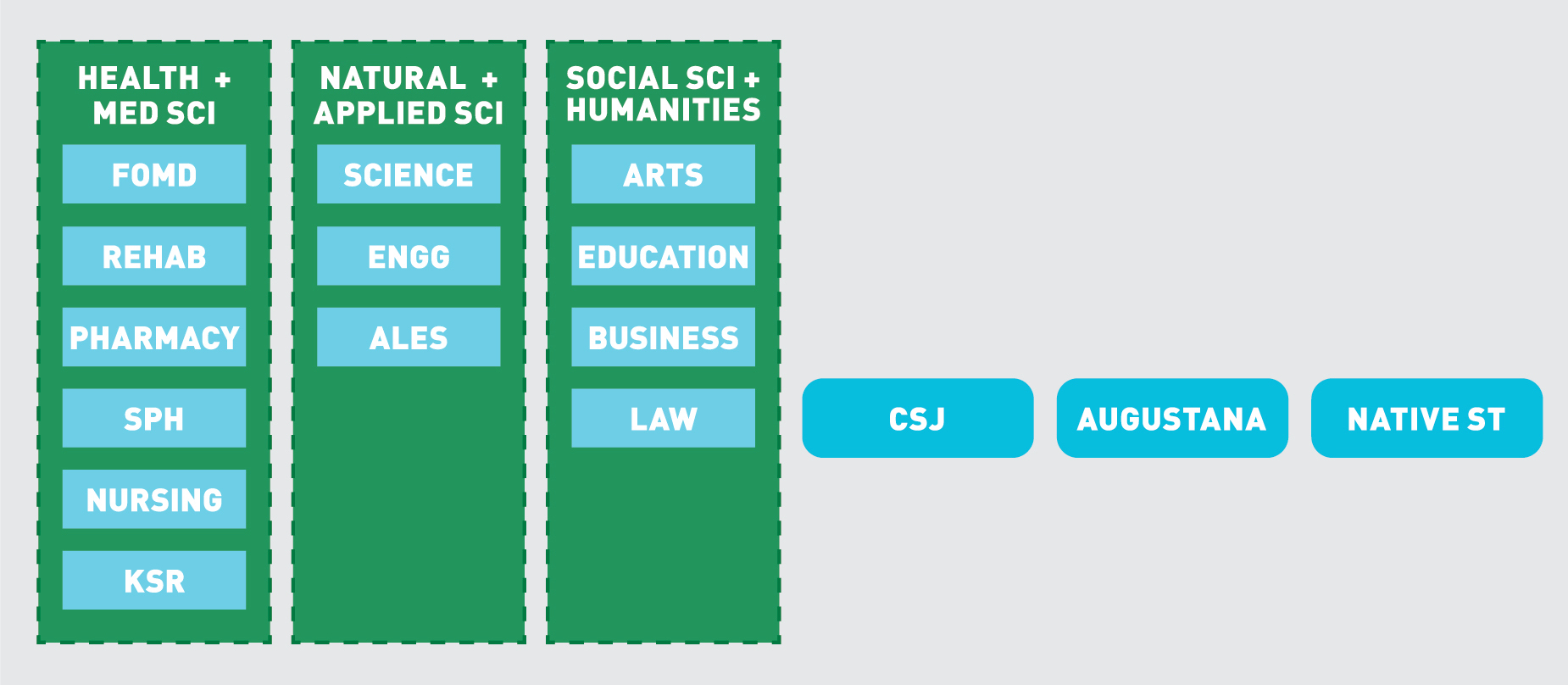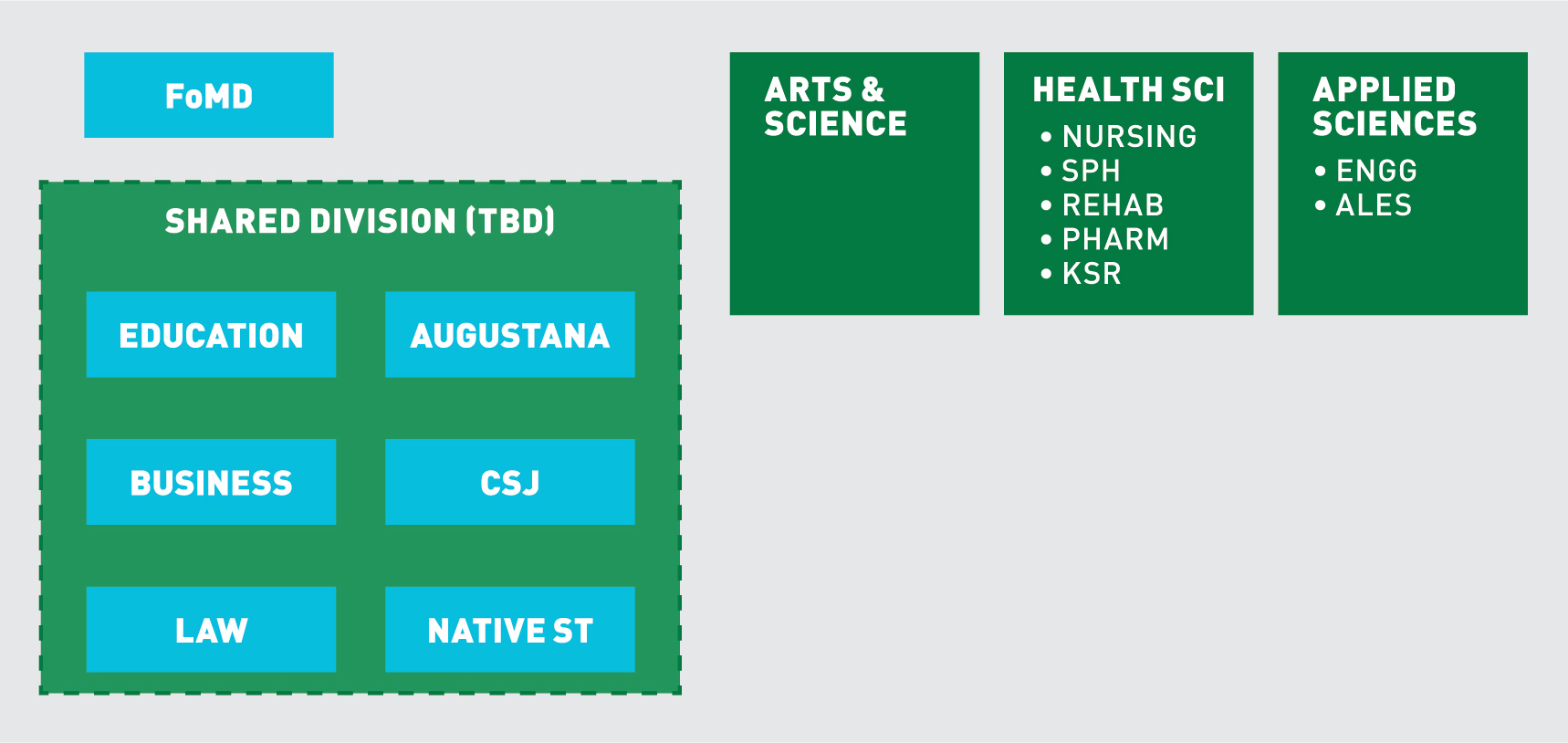Preliminary Scenarios — ARWG Interim Report
Based on an extensive review of possible options, the Academic Restructuring Working Group (ARWG) developed three scenarios of a more collaborative, efficient, and nimble university for consideration by the community. Presented in the ARWG Interim Report, released on September 21, 2020, each scenario represents a distinct philosophical approach and can still be refined and modified through community consultation.
Latest Update
A revised proposal has been presented to the university community for the third phase of consultation, and the ARWG expects to bring a final proposal before GFC and the Board in December for approval.
See revised proposals
Below, you can find details about the proposals contained in the interim report.
Interim Report of the Academic Restructuring Working Group
Scenario A – Health Sciences Consolidation

Health Sciences Scenario: FoMD, Arts, Science, Engineering, ALES, Education, Business, Law, Augustana, CSJ, and Native Studies remain unchanged. Nursing, School of Public Health, Rehabilitation Medicine, Pharmacy, and KSR are consolidated into a new Health Sciences faculty.
- Limited to minor faculty-level changes (only consolidating the health sciences other than Medicine and Dentistry).
- Focussed primarily on department consolidation.
- Offers opportunities for interdisciplinary professional education.
- Common configuration among U15.
- This option is the least disruptive to most of the existing faculties, but realizes the smallest savings.
Scenario B – Tri-Agency Alignment

Tri-Agency Alignment Scenario: CSJ, Augustana, and Native Studies remain unchanged. A Health and Medical Sciences division includes FoMD, Rehabilitation Medicine, Pharmacy, School of Public Health, Nursing, and KSR. A Natural and Applied Sciences division includes Science, Engineering, and ALES. A Social Sciences and Humanities division includes Arts, Education, Business, and Law.
- Major consolidation of faculties into three large divisions, broadly organized by tri-agency areas.
- Organization around tri-agencies is familiar and offers many opportunities for interdisciplinary collaboration in research and teaching.
- By creating a division which contains existing faculty, we retain faculty identity and status--something we heard was important--and also gain the greatest cost efficiencies.
- The division structure enables new forms of academic integration and collaboration, realizes administrative economies of scale, and reduces the number of academic leadership positions.
- The three small community-oriented faculties sit outside this structure as stand-alone faculties.
- This option is the most disruptive to the current organization and how it operates, but offers the greatest potential savings and greatest academic opportunities.
- All faculties are impacted.
Scenario C – Consolidation and Shared Division

Consolidation Plus Shared Division Scenario. FoMD remains unchanged. Three new faculties include a consolidated Arts & Science faculty, a Health Sciences Faculty (which consolidates Nursing, School of Public Health, Rehabilitation Medicine, Pharmacy, and KSR), and an Applied Sciences faculty (which consolidates Engineering and ALES). A new shared division includes the Education, Augustana, Business, CSJ, Law, and Native Studies faculties.
- A hybrid division model.
- Six professional and community-based faculties (Education, Business, Law, CSJ, Augustana, Native Studies) are consolidated into a shared division.
- The remaining current faculties are consolidated into four divisions organized on disciplinary lines (Applied Sciences, Arts and Sciences, Health Sciences, and Medicine and Dentistry).
- Medicine and Dentistry remains intact, given its significant size as is.
- This option requires significant changes to our operating model; realization of academic benefits is not clear.